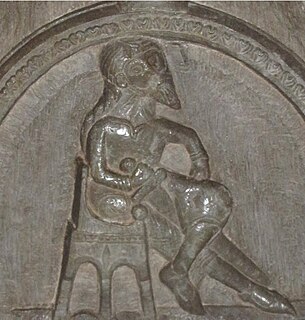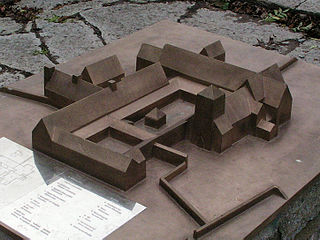Richeza of Poland, a member of the House of Piast, was twice Queen of Sweden and once Princess of Minsk through her three marriages.

The Hootenanny Singers were a popular folk group from Sweden, founded in 1961. The group included Björn Ulvaeus, who later was a member of ABBA. Other bandmembers were Johan Karlberg, Tony Rooth and Hansi Schwarz. The group was named "The Northern Lights" for an American-released LP in 1966.

Charles VII or Carl was ruler of Götaland, and then King of Sweden from c. 1161 to 1167, when he was assassinated.

Sverker I or Sverker the Elder, murdered 25 December 1156, was King of Sweden from about 1132 till his death. Of non-royal descent, he founded the House of Sverker, the rulers of which alternated with the rival House of Eric over the next century.
Magnus Minniskiöld was a medieval Swedish magnate from the House of Bjelbo. For posterity, he is best known as the father of the renowned statesman Birger Jarl, and the ancestor of the later Swedish kings. He is sometimes believed to have perished in the Battle of Lena in 1208, though the evidence is not conclusive.

Barbro Margareta Svensson, better known as Lill-Babs, was a Swedish singer, actress and television presenter. From the early 1950s until her death in 2018, she was one of Sweden's best known and popular singers. She represented Sweden in the 1961 Eurovision Song Contest in Cannes with the song "April, april". She was also well-known for the song "Är du kär i mej ännu Klas-Göran?".

Kol was a Swedish prince who, together with his brother Burislev was a contender for the throne of Sweden from 1167 until his violent death a few years later. The struggle was a stage in the rivalry between the House of Sverker, to which Kol and Burislev belonged, and the House of Eric.

Boleslaw was a Swedish pretender for the throne, belonging to the House of Sverker. He acted in concert with his kinsman Kol against King Canute I of Sweden, then head of the House of Eric. The two pretenders, who were brothers, half-brothers, or uncle and nephew, may never have controlled much more than the Province of Östergötland, which was the base of the dynasty. Boleslaw is believed either to have been murdered by King Canute's men, or to have fled to Poland in or before 1173.

Magnus II; Swedish: Magnus Henriksson was a Danish lord and King of Sweden between 1160 and 1161. He is often seen by posterity as a usurper.
Ulvhild Håkansdotter, , was twice Queen of Sweden and once Queen of Denmark through her successive marriages to Inge II of Sweden, Niels of Denmark, and Sverker I of Sweden. Ulvhild had an important role in the Nordic dynastic connections of her time, but the sources are insufficient on detailed circumstances. She is mentioned as a femme fatale of medieval Scandinavia, as well as a benefactor of the Catholic Church.
Helena or Elin, possibly also known as Maer, Mär or Mö, was Queen of Sweden as the wife of King Inge the Elder, and a supposed sister of King Blot-Sweyn of Sweden.

Helen of Sweden was a Swedish princess and daughter of King Sverker II of Sweden. She was the mother of Queen Catherine of Sweden. She was later Abbess of Vreta Abbey.

Vreta Abbey, in operation from the beginning of the 12th century to 1582, was the first nunnery in Sweden, initially Benedictine and later Cistercian, and one of the oldest in Scandinavia. It was located in the present-day municipality of Linköping in Östergötland.
Cecilia Johansdotter of Sweden is the possible name of the wife of King Canute I of Sweden and mother of King Eric X of Sweden. Little is known about her except that she was of aristocratic origins and died sometime after 1193.
Helen, is the assumed name of a medieval Swedish princess and Danish queen, Queen consort of King Canute V of Denmark. The date of her birth is not known; her father was King Sverker I of Sweden and her mother has been assumed to be Sverker's first spouse, Queen Ulvhild.
Somalis in Sweden are citizens and residents of Sweden who are of Somali ancestry or are Somali citizens. A large proportion of these emigrated after the civil war in Somalia, with most arriving in Sweden after the year 2006.

John, who died between 1150 and 1153, was the eldest son of King Sverker I of Sweden of Sweden and his queen Ulvhild Håkansdotter. He had a role in the outbreak of a war between Sweden and Denmark in the 1150s.
Vulnerable area is a term applied by police in Sweden to areas with high crime rates and social exclusion. In the December 2015 report, these areas numbered 53. In the June 2017 report, these totalled 61. The increase is reported to be due to better reporting, not a changing situation. The overall trend is that these areas are improving.

Harriet Irène Elisabeth K:son Ullberg is a Swedish painter.








